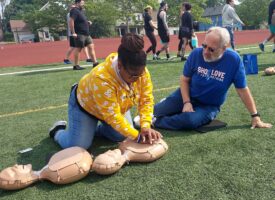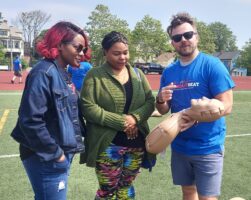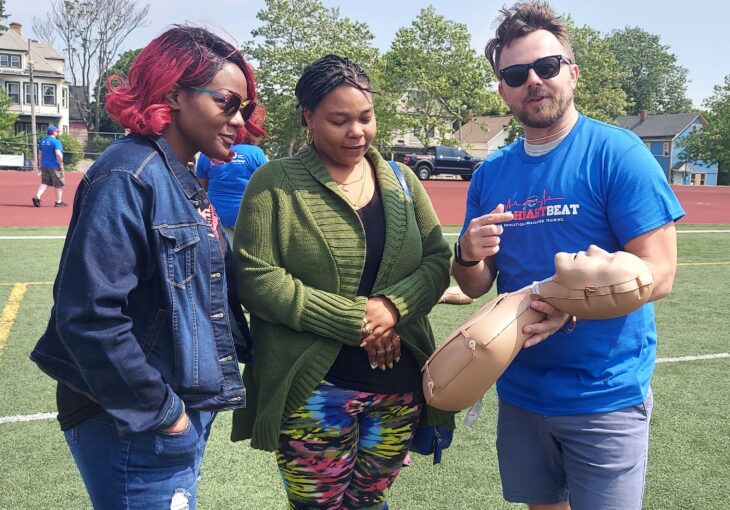
Cliff Miller, right, encourages Stephanie Rogers after both learned Hands-Only CPR at Johnnie B. Wiley Sports Pavilion on Saturday, June 10
Western New Yorkers are working to change the statistics around CPR. Seven in 10 people in America say they feel powerless to act in the face of a cardiac emergency[1]. Thanks to a collaboration between the Buffalo Bills and the American Heart Association, 800 Western New Yorkers gained that power by learning Hands-Only CPR at two events hosted by the Bills and the Association in June. Participants were trained at events held at Highmark Stadium on June 3rd and Johnnie B. Wiley Sports Pavilion on June 10th. The events were supported by Highmark Blue Cross Blue Shield of WNY.
More than 350,000 out-of-hospital cardiac arrests occur in the United States each year[2], according to the Association, which is working to increase the number of bystanders who use CPR in an emergency. More than 90% of people who experience a cardiac arrest outside of the hospital will not survive.
“Less than half of all people who need CPR receive it from bystanders before professional help arrives,” said Jason Stulb, executive director of the American Heart Association, Buffalo/Niagara. “Knowing how to respond in a cardiac emergency when seconds matter can be the difference between life and death. Thanks to support from the Buffalo Bills, we are improving the chances of surviving a cardiac arrest in our community. More people will be ready to respond in those crucial first moments after cardiac arrest.”
The training events were the first part of a five-year, $1 million commitment by the Buffalo Bills. The new program, announced in April, will train thousands of Western New Yorkers in Hands-Only CPR over the next five years through community empowerment events, each aimed at training hundreds of people. Quick, simple and easy-to-learn, Hands-Only CPR has been shown to be as effective in the first few minutes as conventional CPR for cardiac arrest at home, at work or in public[3].

From left, Brianna Kirkland and Tasha Taylor listen to CPR Instructor Matt Bailey during the Hands-Only CPR training on Saturday, June 10, at the Johnnie B. Wiley Sports Pavilion in Buffalo.
The collaboration between the Buffalo Bills and the American Heart Association will also include community education, Bills training camp and game day events, social media awareness and education campaigns and distribution of CPR resources to local youth sports teams and leagues. The goal is to increase the confidence and ability of members of the community to perform bystander CPR. Because about 70% of out-of-hospital cardiac arrests happen at home, odds are the person who needs CPR will be a family member or friend[4].
In addition to the bystander efforts, the American Heart Association and the Buffalo Bills will focus on CPR education for youth sports coaches. During the two training events, CPR & First Aid in Youth Sports™ Training Kits were distributed to youth sports teams in the Western New York community. These training kits are designed for youth coaches to ensure they and their community know the lifesaving skills of CPR, how to use an AED, and how to help during sports related emergencies. Each kit can train approximately 300 people per year. Over the five years of this program, 180,000 people could become potential lifesavers utilizing the kit to learn.
Creating a Nation of Lifesavers means the Association will simultaneously focus on efforts to drive policy change at both the federal and state levels. The Association has endorsed the federal Access to AEDs Act, which would create a grant program for K-12 schools to provide CPR and AED training; purchase AEDs; and create cardiac emergency response plans that establish specific steps to reduce death from cardiac arrest in school settings.
Hands-Only CPR is chest compression-only CPR. Science has shown that following a witnessed cardiac arrest of a teen or an adult, compression-only CPR can be equally effective in the first few minutes of emergency response. If a teen or adult suddenly collapses, witnesses should immediately call emergency services and begin chest compressions at a rate of 100-120 beats per minute and a depth of at least two inches. The Association encourages everyone, regardless of where they live, to take 90 seconds to learn how to save a life now at www.heart.org/HandsOnlyCPR.
[1] 2021 Hands-Only CPR perceptions survey, conducted for AHA https://newsroom.heart.org/news/new-survey-only-6-out-of-10-adults-feel-comfortable-taking-charge-and-giving-cpr
[2] Heart Disease and Stroke Statistics—2022 Update: A Report From the American Heart Association, Table 19-2 https://www.ahajournals.org/doi/epub/10.1161/CIR.0000000000001052
[3] https://www.ahajournals.org/doi/10.1161/CIR.0000000000001052?utm_campaign=2023stat-update&utm_source=heart&utm_medium=link&utm_content=statshome
[4] Heart Disease and Stroke Statistics—2022 Update: A Report From the American Heart Association
